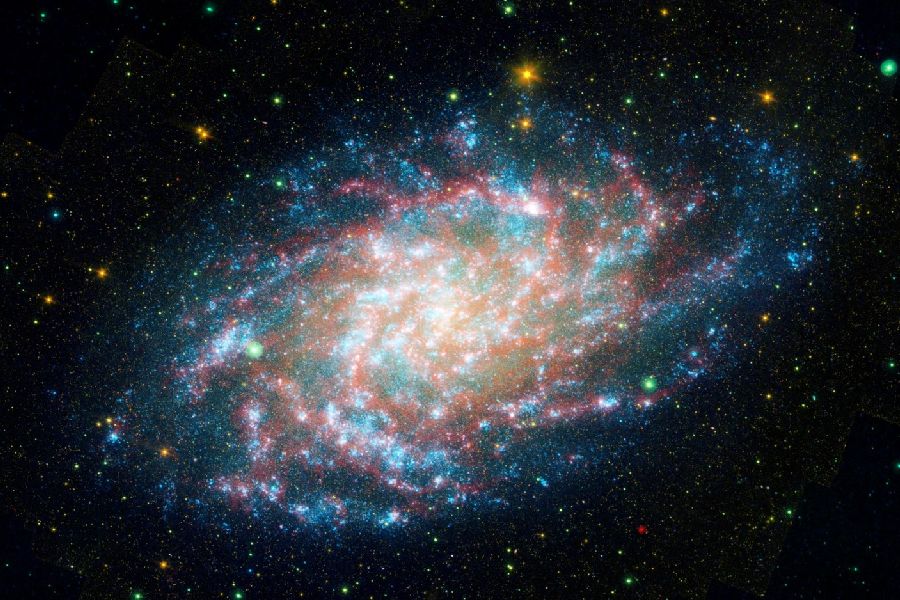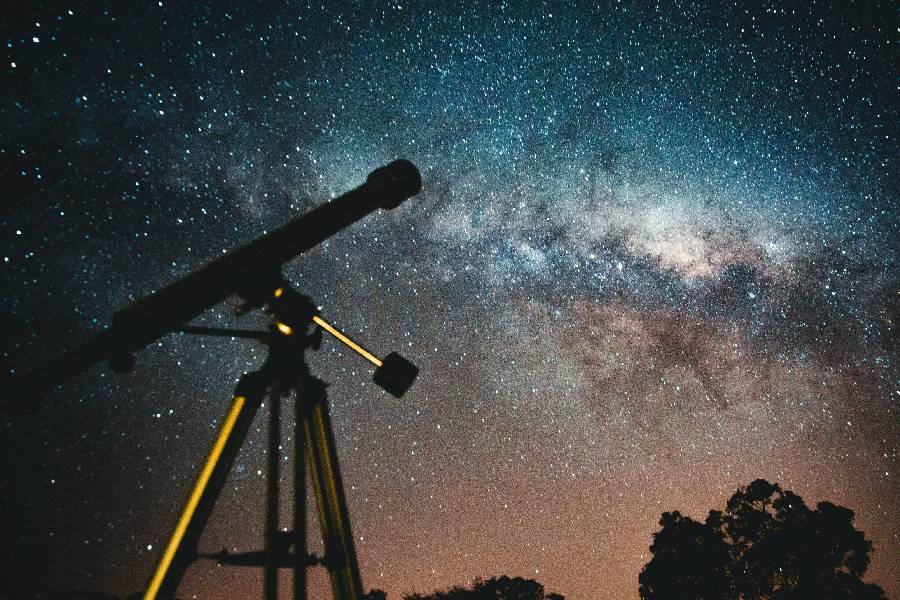There’s a small, under-the-radar galaxy not far from our own that holds big cosmic secrets within its swirling spiral arms. Meet the Triangulum Galaxy – a dwarf spiral galaxy around 3 million light-years from the Milky Way in the constellation Triangulum.
You’ll need a telescope to spot its faint, fuzzy glow, but don’t let its modest appearance fool you. This little galaxy is a powerhouse, churning out newborn stars at rates that leave astronomers starry-eyed.
We’ll take a tour of the galaxy’s structure and contents from end to end, from aging core to gas-clouded spiral arms where hot new stars are bursting onto the scene. And we’ll get the inside scoop on what makes this diminutive galaxy so enormously important for understanding how most galaxies are born, evolve, and eventually meet their demise in our universe.
The Triangulum Galaxy has got stellar stories to tell – now it’s finally getting its turn in the spotlight.

Triangulum Galaxy (Messier 33)
Against the dark canvas of space in the northern constellation Triangulum Galaxy lies a small, faint spiral galaxy that lurks in the shadow of its bigger, flashier neighbors. This galaxy has stayed humble over cosmic timescales, allowing us a valuable peek into what a typical spiral galaxy looks like through the majority of its life.
M33 Triangulum Galaxy distance to Earth is approximately 3 million light-years.
Despite its diminutive size compared to massive galaxies like Andromeda and the Milky Way, the tiny Triangulum Galaxy holds tremendously important clues about the formation and evolution of galaxies in our universe. This dwarf galaxy contains about 40 billion stars.
Cosmic Geography
Triangulum Galaxy’s celestial address
The Triangulum Galaxy graces our night sky within the boundaries of the Triangulum constellation, positioned prominently for observers in the northern hemisphere. Easily spotted by its distinct triangular shape, the galaxy captivates stargazers with its celestial residence.
Within its cosmic neighborhood, the Triangulum Galaxy holds a special significance as part of the Local Group – a collection of galaxies that includes the Milky Way and Andromeda.
Its proximity and interactions with neighboring galaxies contribute to a dynamic cosmic tapestry, offering astronomers a unique vantage point for studying galactic relationships and evolution.
Cosmic Anatomy of Triangulum Galaxy
Structure and composition of Triangulum Galaxy
Unveiling the layers of the Triangulum Galaxy reveals a sprawling cosmic tapestry. Comprising grand spiral arms and a central stellar bulge, this majestic structure spans over 50,000 light-years, showcasing the intricate dance of stars, gas, and dust that defines its celestial canvas.
Notable features abound in the Triangulum Galaxy, making it a celestial spectacle for astronomers and enthusiasts alike. Stellar nurseries, where new stars are born, punctuate its spiral arms, while luminous star clusters and nebulae add a captivating glow.
Embrace the wonder of the galaxy’s grandeur as you explore the intricate details that paint this cosmic masterpiece.
Optimal Times for Gazing Triangulum Galaxy
To witness the Triangulum Galaxy in all its celestial splendor, aim for observation during the fall and winter seasons when the Triangulum constellation dominates the night sky. Clear, moonless nights enhance the viewing experience, providing optimal conditions for stargazers.
For an unobstructed view, venture to dark-sky locations away from urban light pollution. Allow your eyes to adjust to the darkness, and use red-filtered flashlights to preserve night vision.
Employing these best practices ensures a mesmerizing and unhindered exploration of the Triangulum Galaxy’s cosmic beauty.

Tools of cosmic exploration
Telescopes and binoculars
For amateur astronomers seeking to explore the Triangulum Galaxy, a medium-sized telescope with an aperture of 6 to 8 inches proves ideal.
Telescopes such as the Orion SkyQuest series or Celestron NexStar series offer a good balance of affordability and performance, providing clear views of the galaxy’s intricate details.
Entry-level tools cater to learners eager to embark setups. Models like the Celestron SkyMaster series and Orion Scenix let you witness the Triangulum Galaxy’s beauty while allowing gadget-free galaxy gazing.The Scientific Queston their cosmic journey. Binoculars offer an easy way to start observing galaxies without complex
Groundbreaking discoveries
The Triangulum Galaxy has been a focal point for astronomers, revealing key research findings that illuminate its cosmic mysteries. Notably, studies have uncovered insights into its unique structure, star formation patterns, and interactions with neighboring galaxies, offering a deeper understanding of galactic dynamics.
For example, observations have traced Triangulum’s lack of central bar structure to a major galactic merger event over 6 billion years ago that likely disrupted any prior bar formation.
Detailed infrared mapping has also revealed a higher rate of star birth compared to similar dwarf spirals, fueled by a surplus of cold gas likely flowing in from two smaller companion galaxies detected orbiting it.
At radio wavelengths, examinations have identified anomalously long magnetic arms extending far beyond the visible spiral arms, perhaps seeded by shockwaves from that ancient merger. These may help funnel gas into new star-birthing regions. Such discoveries continue revealing the Triangulum Galaxy’s hidden quirks.
Triangulum Galaxy Cosmic Curiosities
- It’s the third-largest galaxy in the Local Group, a cosmic distinction often eclipsed by its more famous neighbors, the Milky Way and Andromeda.
- It harbors a structural enigma – its apparent lack of a prominent central bar feature, which is common in many spiral galaxies.
- Most spirals have elongated central structures, but the Triangulum Galaxy doesn’t. That makes it even more mysterious and intriguing for science enthusiasts.
- Zooming into the core, the Triangulum Galaxy holds another special secret – it likely contains the smallest supermassive black hole detected in any galaxy to date, at only around 30,000 solar masses.
- Even though it’s much smaller than the massive black holes in larger galaxies like the Milky Way, the Triangulum Galaxy has a tiny but powerful core that emits strong X-ray radiation.
- Mapping the Triangulum Galaxy at radio wavelengths reveals an additional surprise – a surplus of hydrogen gas compared to similarly-sized galaxies, perhaps flowing in from a pair of smaller galaxies orbiting it. This reservoir fuels rapid star birth, especially in the galaxy’s southwestern spiral arm.
Conclusion
As we come to the end of our journey through the Triangulum Galaxy, we’re blown away by the beauty and significance of this pocket-sized galaxy. Despite its small size, it gives us a unique glance into the inner workings of spiral galaxies.
The captivating images of the Triangulum Galaxy in different colors remind us of the beauty that exists across the universe. And the secrets it holds are now enlightening galaxies near and far.
We bid farewell to this captivating glimpse into the inner workings of galaxies The Triangulum Galaxy will continue to gracefully spin in the night sky, keeping its secrets for countless ages to come.
Frequently Asked Questions
Where and how far away is the Triangulum Galaxy located?
The Triangulum Galaxy resides in the northern constellation Triangulum, which translates to “the Triangle” – a fitting name for this cosmic neighbor’s location. At a distance of around 3 million light-years from Earth, it is one of the closest major galaxies to our Milky Way.
How big is the Triangulum Galaxy?
While prominent in our skies, the Triangulum Galaxy is quite petite for a spiral galaxy. It spans approximately 60,000 light-years across, making it less than half the size of our home Milky Way galaxy, which is at around 100,000-200,000 light-years in diameter. Researchers categorize it as a dwarf spiral galaxy.
What features does the Triangulum Galaxy have?
The Triangulum Galaxy shows off the classic features of a spiral galaxy – a bright, active core region surrounded by distinct spiral arms rotating around it. These arms host glowing pink and red stellar nurseries where new stars are actively forming. The nucleus also harbors a supermassive black hole.
Why do astronomers study the Triangulum Galaxy?
Astronomers study the Triangulum Galaxy because its smaller size and structural features resemble what spiral galaxies look like through the majority of their lifecycle. This makes it the ideal testbed for computer model simulations of galactic evolution and dynamics. Insights can then be applied to unlocking the past and future of larger galaxies.
How can I observe or see the Triangulum Galaxy?
Locating the Triangulum Galaxy requires a telescope with a moderate aperture – 8 inches or greater is recommended. It can be spotted as a faint, oval smudge in the constellation Triangulum.
Small telescopes will reveal its glowing core while large telescopes show some details of its spiral arms. Astrophotographers can also capture its structure using long-exposure deep-sky imaging techniques.
